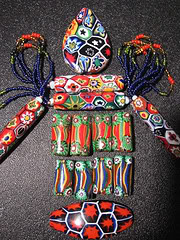This article will provide you with the instructions you need to make your own Fimo beads (polymer clay beads) at home, regardless of whether you’ve ever done it before or not–in fact, it’s generally written for beginners. The article includes very simple step-by-step instructions, plus pictures illustrating each step, and I’m also going to include two different videos by two different people showing how they make Fimo beads, and there’s a list of resources (links) at the bottom that I feel are particularly pertinent.
What is polymer clay?
Polymer clay isn’t your typical clay. It’s actually a plastic known as polyvinyl chloride. When it’s malleable it can be molded, sculpted, and embossed to take on the shape of your creation. Once you bake it at low heat the particles fuse together to create a hard, durable material that you can sand, paint, or drill. The most popular brand of polymer clay is FIMO Clay which has become a household name and a term commonly used for all polymer clay.
History of Fimo
FIMO Clay was the accidental discovery of a doll maker’s daughter in late 1930s Germany. In the 1960s the product received a licensing for industrial production and other polymer clay manufacturer equivalents started popping up.
Fimo is derived from the original inventor’s nickname, Fifi. Fimo is usually capitalized as FIMO since it’s branded that way by the manufacturer.
How are Fimo beads made?
This is the first of two videos I’ve got that give you a great quick overview of how Fimo beads are made at home–I recommend that you watch it to just quickly get an idea of what you’re going to have to do, and then use the step-by-step instructions-with-pictures that I’ve got below to follow as you’re actually doing it for the first time. The second video is at the bottom of this page just above the links, enjoy:
Techniques
Since FIMO Clay has all the benefits of traditional
| clays, polymer clay artists use traditional clay techniques that have been around for centuries. The most popular techniques are cane work and millefiori (which literally means a thousand flowers). These methods were widely used by the Italians in glasswork and |
popularized by the Venetians several hundred years ago.
Materials and Equipment You’ll Need (plus some recommended reading)
Choosing the Right Clay
There are various brands of clay and they are all basically the same. Some can be more malleable that others, which for making beads is usually preferred but it depends on your project. After you get some experience with different clays you will know which ones you prefer for which projects.
Most clay is sold in small blocks such as 56 gram FIMO blocks. Basic colors can also be bought in large blocks. If you’re a beginner I suggest buying the small packets until you know your preferences on clay color and type.
Here are some different types of polymer clay:
Traditional Polymer Clay: This is the original polymer clay–malleable and durable once baked. What I highly recommend you do, whether you’re going to order from them or get this stuff from your local art supply store (if you are then this way you’ll know what to look for), is go over to Amazon and check out the following products, this is what I recommend:
- Sculpey III Classic Collection 10 Pack
- Bundle Monster 100 PC 3D Designs Nail Art
- Sculpey III Sampler
- Also, I’d highly recommend you pick up a proper set of sculpting and carving tools such as this: 11-piece Pottery / Sculpture Tool Set, Clay & Wax Carving Tools
In addition to that, if Fimo is something that you are genuinely interested in and really want to learn more about in-depth (more that what I can possibly cover here), there are several books that I recommend out of the dozens that are available on Fimo. My personal top 3 are:
- The Polymer Clay Techniques Book
- Making Polymer Clay Beads: Step-by-Step Techniques for Creating Beautiful Ornamental Beads
- The Art of Polymer Clay Millefiori Techniques: Projects and Inspiration for Creative Canework
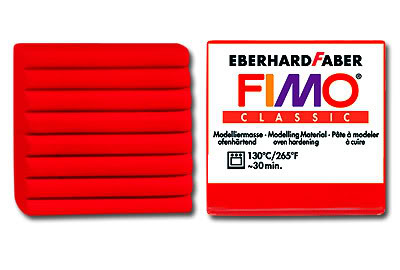
Softer Polymer Clay: This clay is slightly more malleable and great for beading projects. The finished project still turns out durable. Get it here: Staedtler Fimo Soft Polymer Clay – 24-Color Set
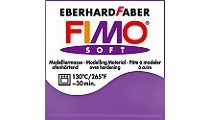
Doll Making Clay: This clay is stiffer than the others and very strong after baking.


Mix Quick: This medium is mixed with FIMO Clay to make it more malleable and easier for children to use. Follow manufacture’s age requirements.
NOTE: If you make your clay too malleable the colors on intricate beads tend to smear so using excessive amounts of Mix Quick is not recommended for intricate cane and millefiori work.
FIMO Clay comes in a variety of colors and effects. These can then be mixed to create even more colors so there are endless possibilities.
There are a variety of pre-made clays which produce a variety of effects. They include:
- Glamour clay which gives your final project a metallic or iridescent quality
- Mottled stone clay is available in a number of colors and will give your project an imitation stone effect.
- Glow-in-the dark clay which is especially fun for Halloween
- Translucent clay will give your project the appearance of glass
- Fluorescent clay which children really enjoy
Storing Clay
Wrap your clay in wax paper and place it in an airtight storage container. Store your FIMO Clay in a cool place away from ultraviolet light. If properly stored, FIMO Clay can last for approximately 2 years.
Paint and Finishes
Since FIMO Clay comes in a variety of colors and effects it is not necessary to use paint or finishes. Depending on your project though, you may want to experiment before mixing large amounts.
Here are some paints and finishes you can incorporate into your designs:
- Metallic Leaf Metal sheets come in gold, silver, copper and aluminum and are available from craft stores.
- Bronze powders are available in a wide range of colors at art specialty shops.
- Varnish can give your work a glossy or matte finish.
- Acrylic paint comes in a variety of colors.
- Enamel paint is best for painting small areas or intricate patterns.
Assembling Materials
Depending on your finished project, many assembling materials can be purchased from craft or art supply stores. This includes:
- Jewelry wire of different gauges for stringing beads
- Clip-on and loop earring backs
- Posts with a safety-pin back for making such things as broaches
- Elastic string for making bracelets
Equipment
Making FIMO projects, especially FIMO beads, takes very little equipment and most tools you can find around the house or at a drug store.
Essential equipment includes:
- A craft knife. I find that a wide blade has the best universal use.
- Tools for rolling out and flattening clay. This can be a brayer or vinyl or glass rolling pin.
- A small piece of plexiglass or other lightweight flat object for making canes
- Skewers and toothpicks for making holes in beads and for baking
- An oven or a convection oven for finishing your project. Microwave ovens and toaster ovens CAN NOT be used.
- A non-textured plastic cutting surface to protect your table and craft knives
- Pins, knitting needles, buttons, and other odds and ends for molding and sculpting your creation.
The more advanced your craft becomes the more equipment you may want to purchase. Your local craft store or art supply store has a variety of tools for clay work.
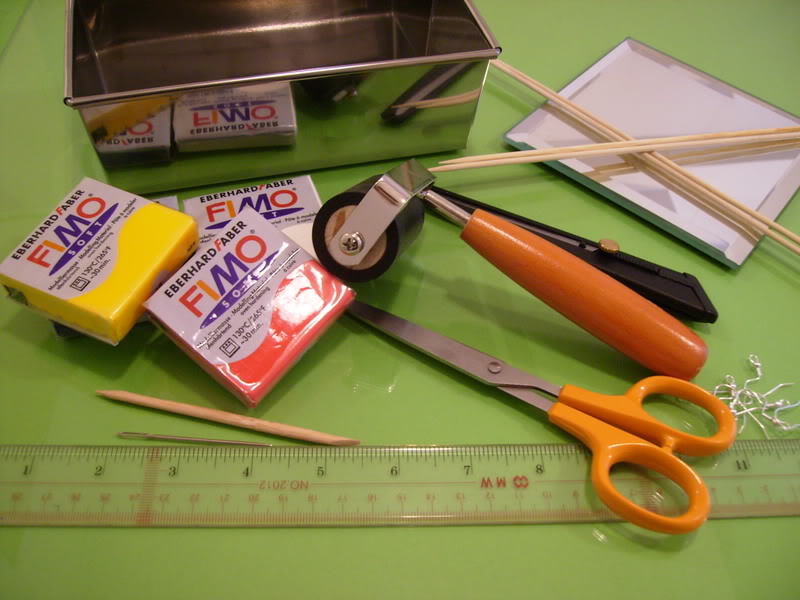
Basic Techniques
Preparing FIMO Clay
Before you can start creating with FIMO Clay you need to get the clay a bit soft and playable. To do so, cut off no more than an 8th of a block and knead it with your hands. Roll it between your hands to make a sausage and then bend it in half and repeat the process until it becomes soft. Try not to let air bubbles get into the clay.
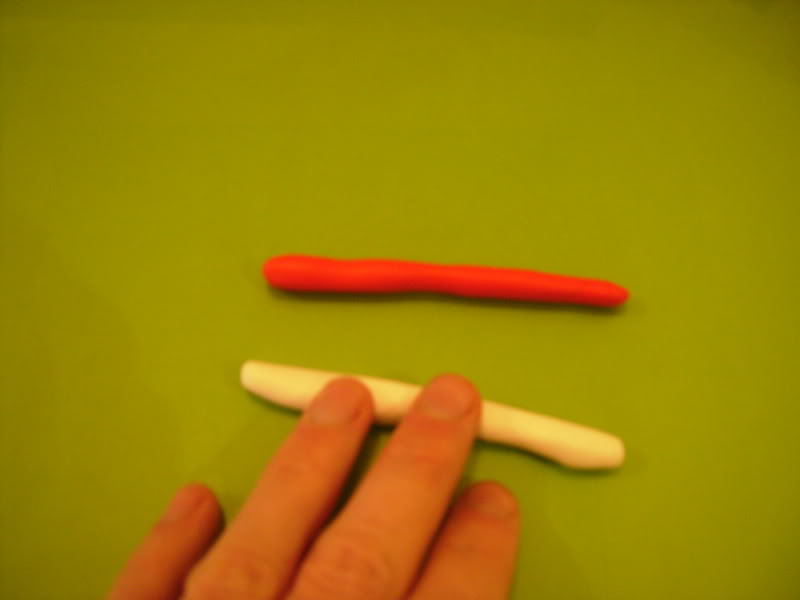
Something to keep in mind is the temperature of your work area. If it is cool and you’re having a hard time kneading the clay, you may want to store the clay in a slightly warmer area or put the sealed clay in your pocket before working with it.
Mixing Colors
Although FIMO Clay comes in a variety of colors, you can also combine colors to suit your project.
TIP! When mixing dark and light colors, mix in only a small amount of the dark color at a time since it can easily overpower the lighter color.
To mix clay:
- Roll your clay into sausages.
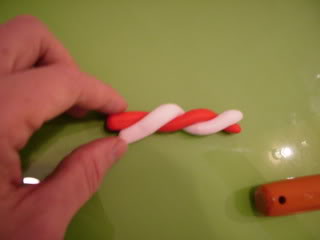
- Twist the two colors like a candy cane.
- Continue twisting and kneading until the two colors are mixed.
TIP! Once you get your colors decently mixed by hand, you can roll them out flat and then fold over and continue kneading. Roll it out again and continue the process making sure not to catch air pockets. This will guarantee all your clay is mixed.
Once you get more involved in your clay crafts you may want to consider buying a pasta making machine. It saves time mixing and rolling out colors.
Rolling Out
Roll out your clay on a smooth, clean surface. Use an acrylic rolling pin or a brayer and make sure the clay is rolled out evenly.
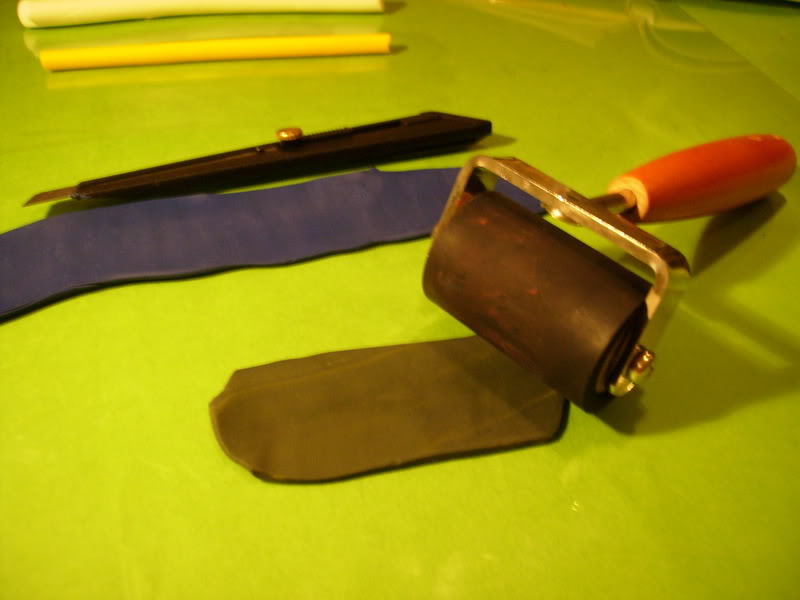
TIP! If your clay starts sticking to the rolling surfaces dust it with a little flour or talcum powder.
Cane Work
A cane is a log of clay with a pattern running through it. It is derived from ancient clay and glass working techniques.
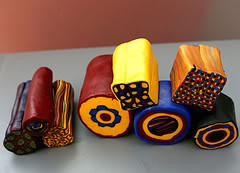
The designs can be simple or you can make a complex pattern or image. You can then reduce the canes and slice the canes to make multiple images and patterns in various sizes.
Here is an example of a very simple layered cane:
- Using a small piece of plexiglass, roll a log that is no more that four inches long. This will be the center of your cane.
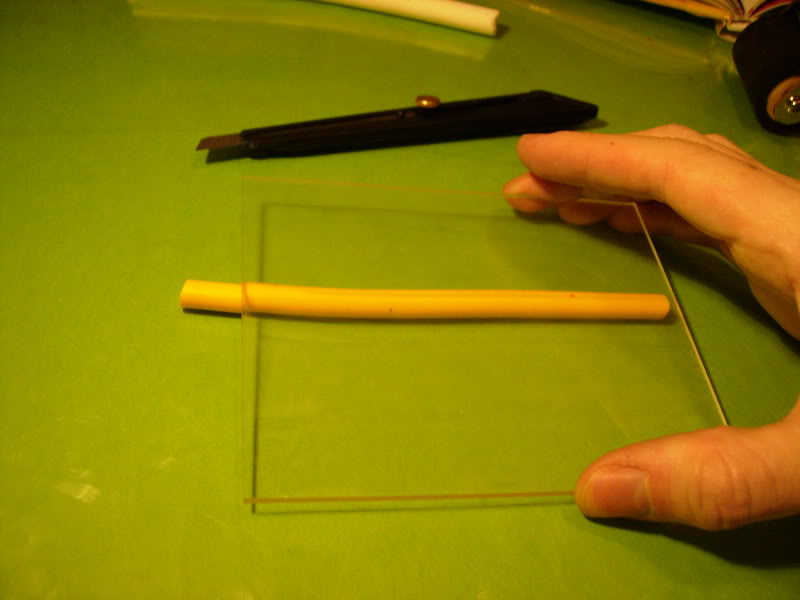
- Using a rolling pin or brayer roll out clay of a contrasting color into a thin sheet. Wrap this around the log and smooth out the seam by gently rolling the cane with your sheet of plexiglass.
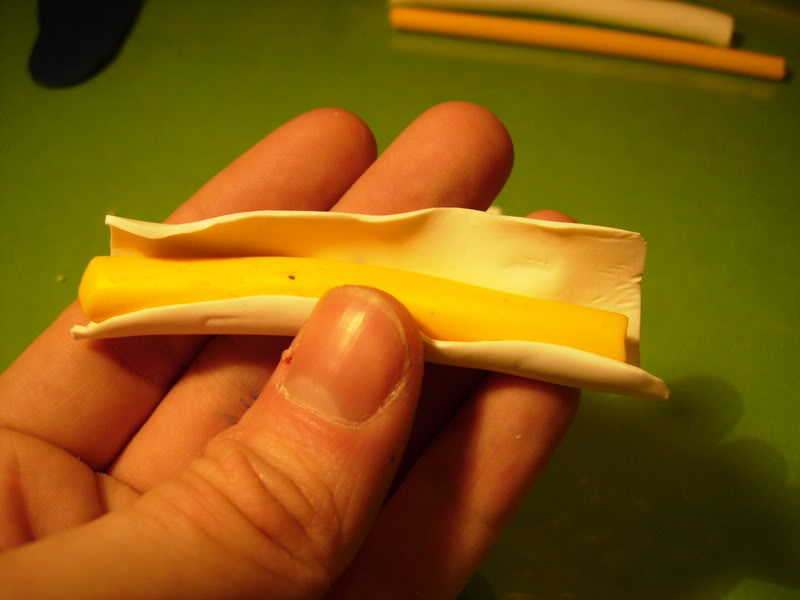
- Repeat step two in an alternating color pattern (blue, green, blue, green, etc) or contrasting colors (yellow, blue, white, red, etc.). You can also alternate the thickness of the sheets to make a more whimsical pattern.
- After you have completed the amount of layers you desire gently roll it with a sheet of plexiglass to join the seams and trim the ends with a knife.
Now that you have a cane, there are many things you can do with it including:
- Make cylinder type beads by simply slicing the canes in different lengths. The diameter of the beads can be varied by just rolling the cane before slicing. You can make the same bead in various sizes.
- Thinly slice the canes and attach the slivers to projects such as millefiori beads.
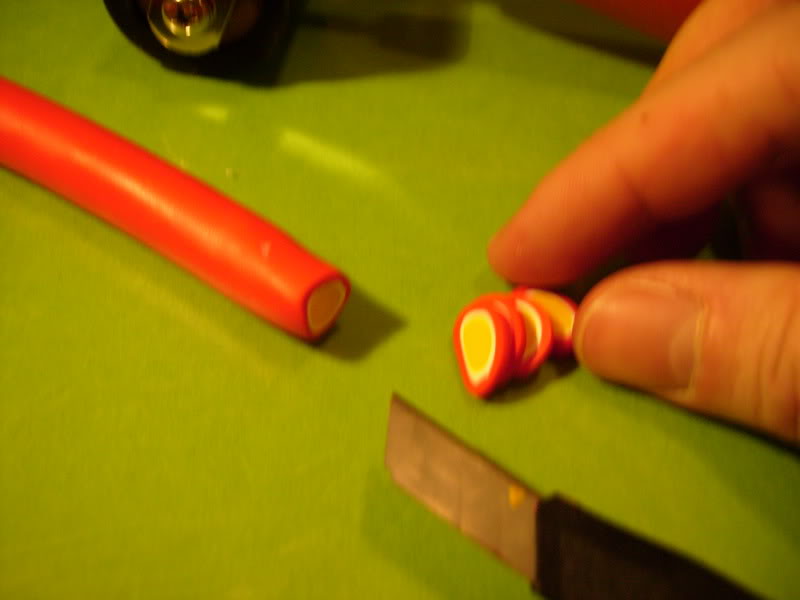
TIP! If your clay gets too warm and malleable, the colors may run and slicing canes may not be even. You can fix this by placing your cane in the refrigerator for about an hour before slicing it.
Making Beads
FIMO beads can be made into many different shapes and sizes. In addition to a multitude of shapes and sizes, beads can be decorated by using different techniques and different finishes so the possibilities are endless.
Simple Beads
Simple beads can be incorporated into your project as-is or you can use them as a base for more intricate beads.
Round Beads
Round beads can be made by simply rolling the clay in your hands or using your sheet of plexiglass by placing the clay under it and moving the plexiglass in a circular motion.
Cylinder Beads
Cylinder shaped beads are made by rolling a piece of clay under plexiglass, trimming the ends, and then slicing the log into the desired length of beads.
Oblong Beads
Make a round bead and then gently roll it under plexiglass in an up-and-down fashion until you achieve the desired shape.
Square Beads
Square and rectangular beads can be made by simply using your craft knife to carve it from a piece of clay.
TIP! You have a better chance at getting all the sides even and all the beads the same size by rolling a round bead first and then cutting off six even sides.
Whimsical Beads
Beads can be made into any shape that will be large enough to make a hole for threading. For example, I like to make a square bead and then gently apply pressure to all six sides with my finger tips to make a concaved square.
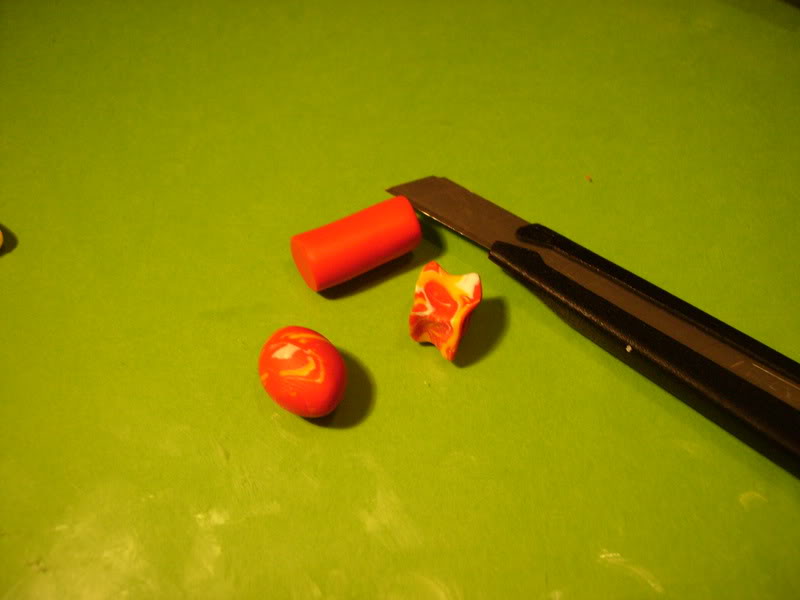
TIP! Excess pieces of clay can be made into simple beads and then used as a base for placing your patterned cane slices. The base color of the bead doesn’t matter as long as you cover it completely.
Making a Hole
To make a hole in the bead for threading you have two options:
After you are done shaping the beads use a wooden skewer and gently start the hole in one side of the bead. Roll the skewer back and forth between your fingers to drill the hole through the bead. Fill up the skewer with beads, being careful they do not touch. Now you are ready for baking!
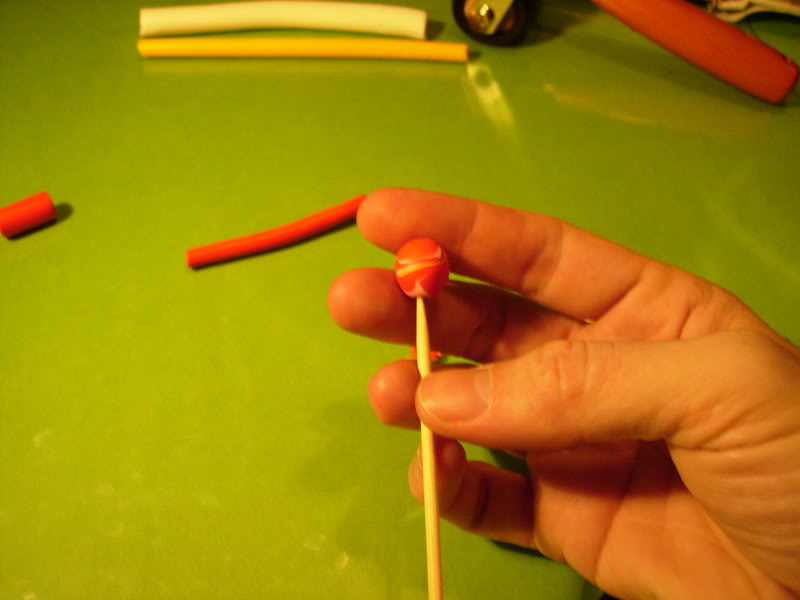
TIP! Be careful not to distort the bead when making a hole. Fix any distortion after the beads are placed on the skewer. To prevent distortion, you may want to drill the beads after they are baked. See below.
You can also bake beads and then drill a hole in the beads after they are baked. There is more work involved but you don’t have to worry about distorting them and the end result can be more professional.
Baking Beads
Beads can either be strung on a wooden skewer or they can be placed between sheets of cardboard. It is important that they do not touch or they will fuse together in the baking process. Suspend them on a metal tray. Bake according to manufacturers specifications.
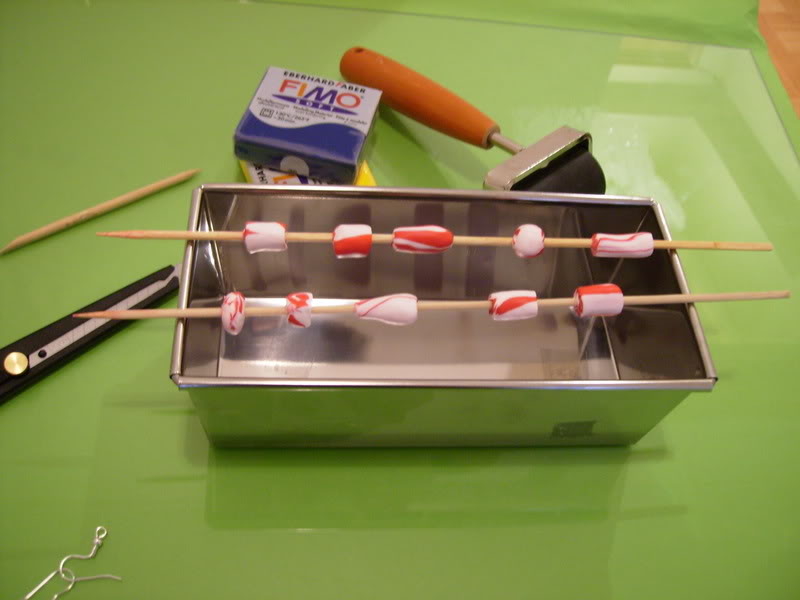
TIP! After your bake your beads sand off any excess around the hole opening.
Marble Beads
Marble looking beads can be made easily and the end result can be a stunning piece of jewelry.
It is much like mixing clay; however, you do not completely mix the clay so you are left with a marbling effect.
- Roll your clay into sausages.
- Twist the two colors like a candy cane.
- Continue twisting and kneading until the two colors make a marble pattern. The more you mix, the more variegated your pattern will be.
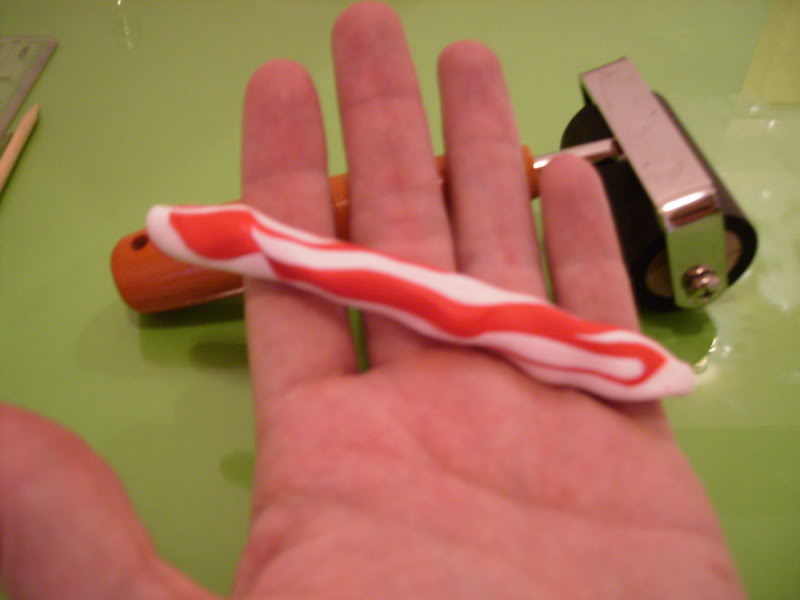
- Shape your clay into the bead shape or shapes you desire.
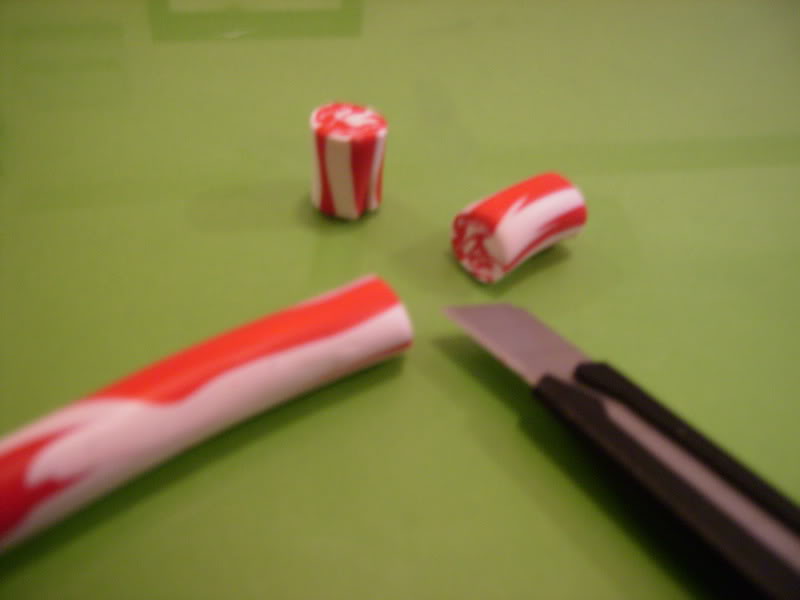
- Make the threading holes (or drill later) and bake according to the manufacture’s directions.
Complex Cane Work
Now that you have created some basic canes now you can create more complex canes and eventually make millefiori beads which literally means “thousand flowers”.
Here are instructions for a basic flower:
- Using your piece of plexiglass roll a small yellow log about 4 inches long. This will be the middle of your flower.
- Roll a white log about 3 times thicker than your yellow log.
- Cut the white log lengthwise into 4 equal pieces and trim about 1/8th of an inch off the center wedge.
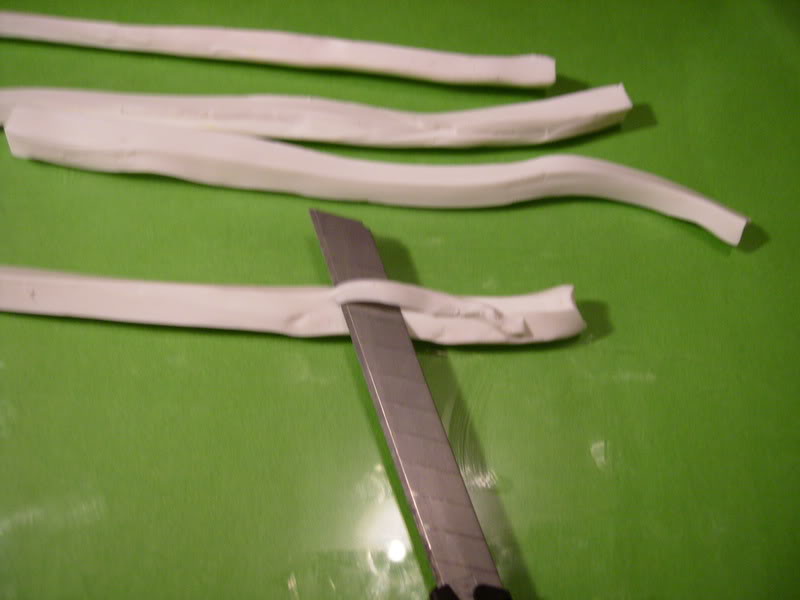
- Roll out flat a thin strip of blue clay and cut it into 4 strips the same width as the quarter white log pieces
- Assemble the cane with the yellow log in the center and alternating the blue strips and white quarter logs around the yellow log. Gently press the clays together to give the clay a temporary hold.
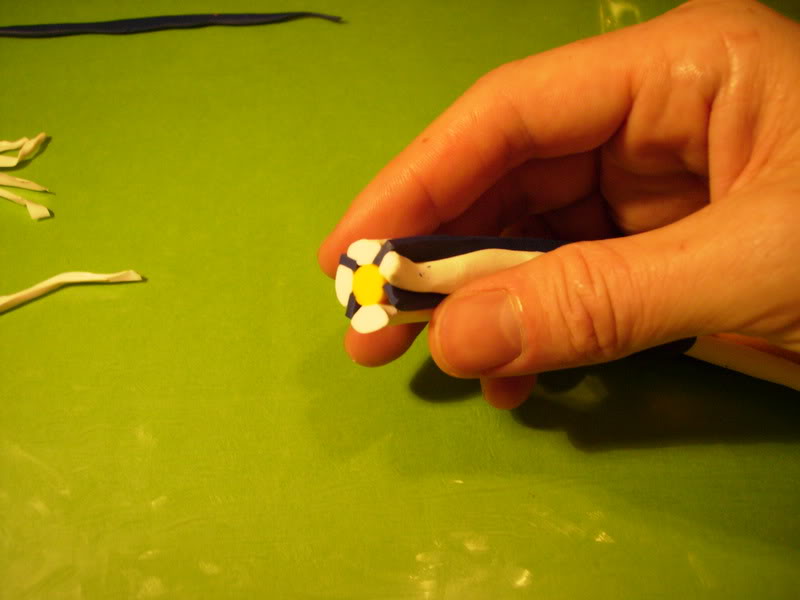
- Roll out a thin strip of light blue clay and wrap the cane with the strip. Gently roll out the cane with your plexiglass to smooth the seams. Trim the edges.
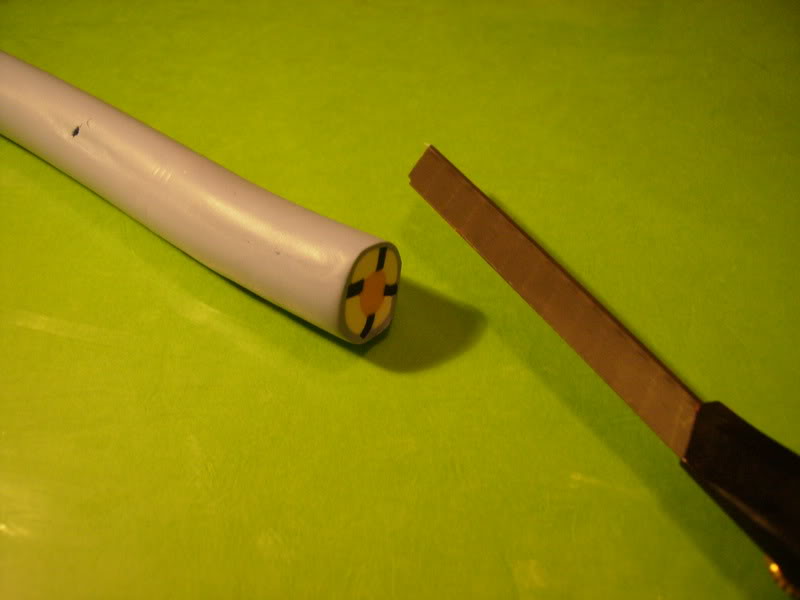
- Now that you have your cane you can roll it out to the desired diameter and thinly slice it. You can continue to decrease your cane and make pattern pieces of various sizes.
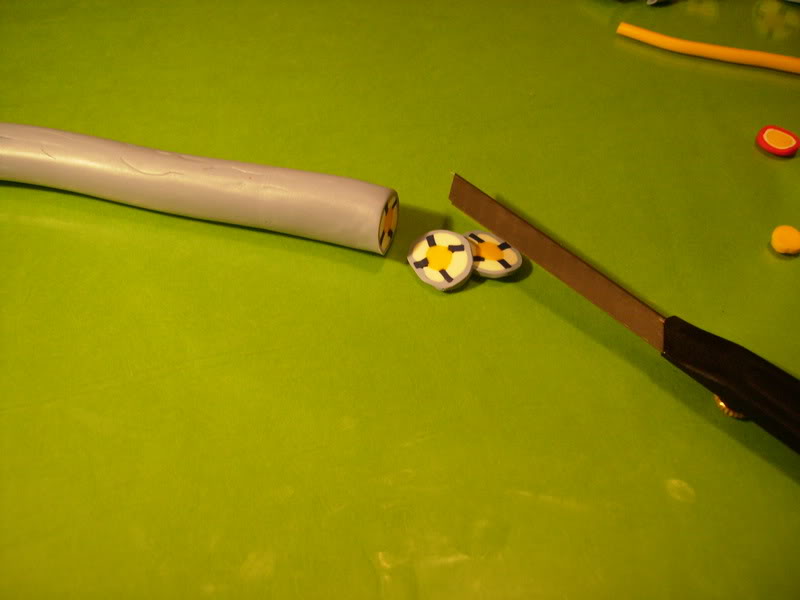
- Attach your pattern pieces to pre-made baked beads or uncooked beads. After you have a bead covered, gently roll the bead to blend the seams.
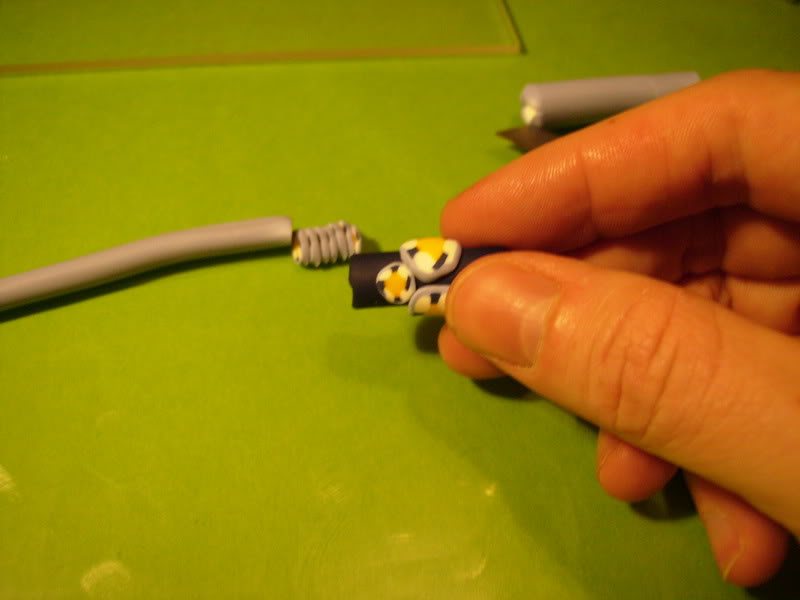
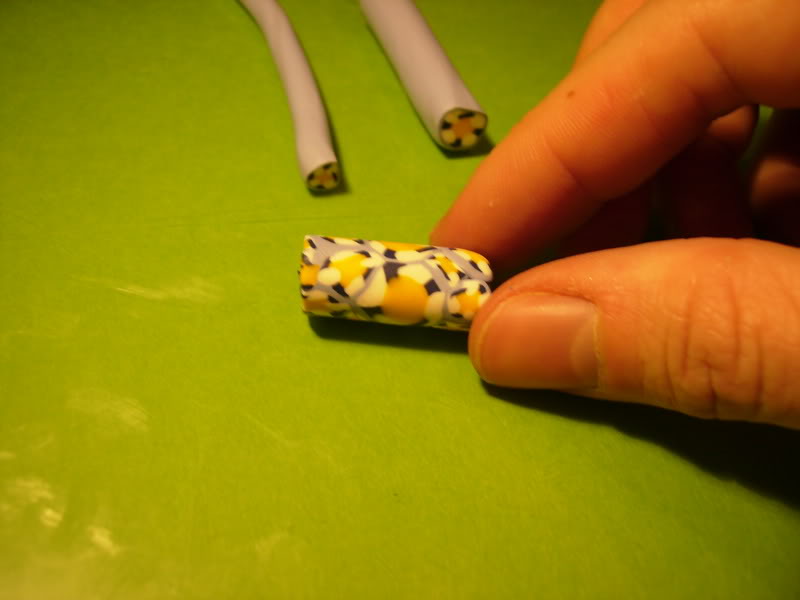
- String the beads on a skewer and bake according to manufacturer’s specifications.
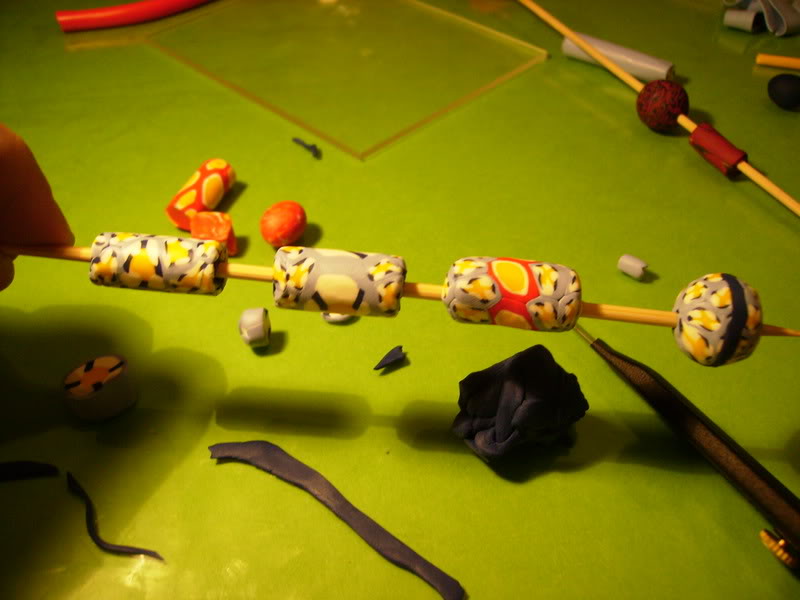
Now that you have made a more complex cane you can use more layers and make more ornate flowers and even images such as hearts and letters.
After your beads have cooled you can spray them with a glossy finish to give them a glassy appearance or leave them as-is.
Here’s the second video, I think this one might be just a bit better since it includes audio instructions:
Further Reading and Other Resources
Wikipedia Article on Fimo Beads
Very cool blog about polymer clay beads: How to make beads from Polymer Clay
Another nifty blog about polymer clay beads, here’s the description on the site:
“I started making Polymer clay beads in 2005. I sold my first batch and started sending them out to the bead stores and bead shows. I started a blog to share my experieces with polymer clay and started a tutorial blog to show how I make some of my beads. Now I add my on-line store so you can buy what you want here.”
Check it out here: Silastones
